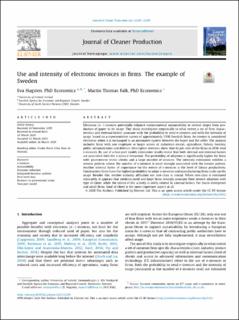| dc.contributor.author | Falk, Martin Thomas | |
| dc.contributor.author | Hagsten, Eva | |
| dc.date.accessioned | 2020-12-02T14:31:55Z | |
| dc.date.available | 2020-12-02T14:31:55Z | |
| dc.date.created | 2020-11-30T21:06:09Z | |
| dc.date.issued | 2020 | |
| dc.identifier.citation | Hagsten, E. & Falk, M. T. (2020). Use and intensity of electronic invoices in firms: The example of Sweden. Journal of Cleaner Production, 262, 121291. | en_US |
| dc.identifier.issn | 0959-6526 | |
| dc.identifier.uri | https://hdl.handle.net/11250/2711559 | |
| dc.description.abstract | Electronic (e−) invoices potentially enhance environmental sustainability in several stages from production of paper to its usage. This study investigates empirically to what extent a set of firm characteristics and external factors associate with the probability to send e-invoices and with the intensity of usage, based on a representative survey of approximately 1500 Swedish firms. An invoice is considered electronic when it is exchanged in an automated system between the buyer and the seller. The analysis includes firms with one employee or larger across all industries except, agriculture, fishery, forestry, public administration and defence. Descriptive statistics show that 42 per cent of the firms in 2016 send e-invoices. By use of a two-part model, estimation results reveal that both internal and external factors are associated with the e-invoice behaviour. The probability of adoption is significantly higher for firms with government sector clients and a large number of invoices. The intensity estimation exhibits a reverse pattern, where the number of e-invoices is most strongly associated with the invoice pattern. Another internal factor of importance for the extent of e-invoices is the level of labour productivity. Construction firms have the highest probability to adopt e-invoices and manufacturing firms scale-up the usage. Besides this, neither industry affiliation nor size-class is crucial. When size-class is estimated separately, it appears that medium-sized and large firms strongly associate their invoice adoption with type of client, while the extent of the activity is solely related to internal factors. For micro enterprises and small firms, kind of client is the most important aspect at all. | en_US |
| dc.language.iso | eng | en_US |
| dc.rights | Navngivelse 4.0 Internasjonal | * |
| dc.rights.uri | http://creativecommons.org/licenses/by/4.0/deed.no | * |
| dc.title | Use and intensity of electronic invoices in firms: The example of Sweden | en_US |
| dc.type | Peer reviewed | en_US |
| dc.type | Journal article | en_US |
| dc.description.version | publishedVersion | en_US |
| dc.rights.holder | © 2020 The Authors. Published by Elsevier Ltd. | en_US |
| dc.source.volume | 262 | en_US |
| dc.source.journal | Journal of Cleaner Production | en_US |
| dc.identifier.doi | 10.1016/j.jclepro.2020.121291 | |
| dc.identifier.cristin | 1854529 | |
| dc.source.articlenumber | 121291 | en_US |
| cristin.ispublished | true | |
| cristin.fulltext | original | |
| cristin.qualitycode | 2 | |

